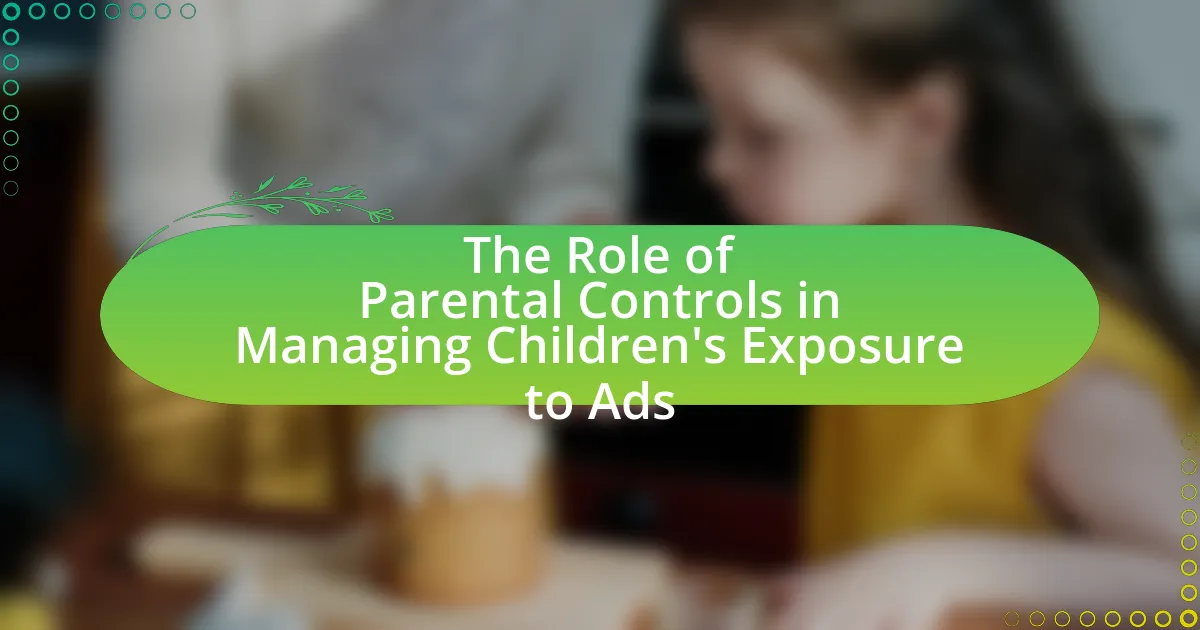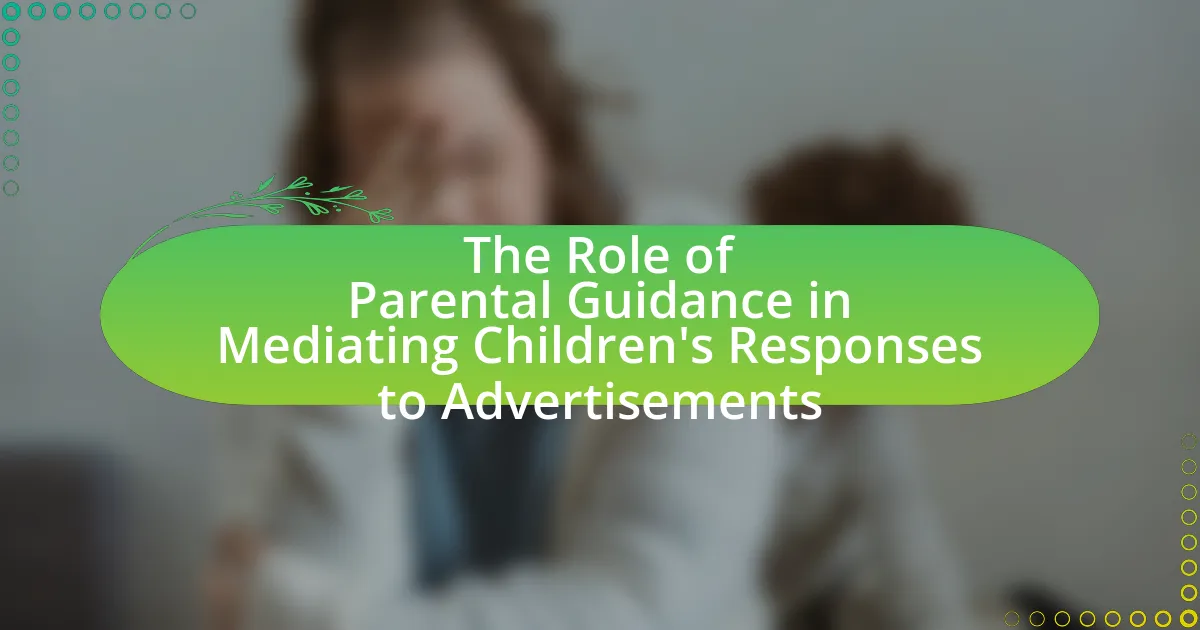The article examines how advertising influences family dynamics, focusing on its impact on consumer behavior and family interactions. It highlights the ways advertising shapes purchasing decisions, values, and communication patterns within families, particularly emphasizing children’s roles in influencing parental choices. The article also discusses parents’ perceptions of advertising’s effects on their children’s values and behaviors, as well as strategies they employ to mitigate advertising’s influence. Additionally, it addresses the importance of media literacy in fostering critical thinking about advertising messages and offers practical tips for families to navigate the complexities of advertising in today’s media landscape.

How does advertising influence family dynamics?
Advertising influences family dynamics by shaping consumer behavior and family interactions. Families often make purchasing decisions based on advertisements, which can create conflicts or alignments in preferences among family members. For instance, a study by the American Psychological Association found that children exposed to targeted advertising are more likely to influence their parents’ buying choices, leading to increased family discussions about products and spending. This dynamic can either strengthen family bonds through shared interests or create tension when preferences clash, illustrating the significant role advertising plays in family decision-making processes.
What are the primary ways advertising impacts family interactions?
Advertising primarily impacts family interactions by influencing purchasing decisions, shaping values and norms, and affecting communication patterns. Families often engage in discussions about products and brands presented in advertisements, which can lead to collective decision-making regarding purchases. For instance, research indicates that children can significantly sway family buying choices, with studies showing that children influence up to 40% of family spending decisions. Additionally, advertising can shape family values by promoting specific lifestyles and ideals, which may alter how family members perceive each other and their roles within the family unit. Furthermore, the content of advertisements can affect communication dynamics, as families may bond over shared interests in certain products or brands, or conversely, experience conflict over differing preferences.
How do advertisements shape children’s perceptions of family roles?
Advertisements shape children’s perceptions of family roles by presenting idealized and often stereotypical representations of family dynamics. For instance, commercials frequently depict mothers in nurturing roles and fathers as providers, reinforcing traditional gender roles. Research by the American Psychological Association indicates that children exposed to such advertisements are more likely to internalize these roles, believing that they reflect real-life expectations. This exposure can lead to the normalization of specific behaviors and responsibilities associated with each gender within the family context, ultimately influencing how children view their own roles and those of their family members.
In what ways do parents respond to advertising messages within the family?
Parents respond to advertising messages within the family primarily by influencing their children’s purchasing decisions and shaping their attitudes towards products. Research indicates that parents often act as gatekeepers, filtering the information their children receive from advertisements and guiding them towards or away from specific brands based on their own values and beliefs. For example, a study published in the Journal of Consumer Research found that parents who are more involved in their children’s media consumption tend to have a significant impact on their children’s brand preferences and purchasing behavior. Additionally, parents may engage in discussions about advertisements, helping children to critically evaluate marketing messages, which further reinforces their role in mediating the effects of advertising within the family context.
Why is understanding advertising’s effect on families important?
Understanding advertising’s effect on families is important because it shapes consumer behavior and influences family dynamics. Advertising can impact children’s preferences, parental purchasing decisions, and overall family interactions. Research indicates that children exposed to targeted advertising are more likely to request advertised products, which can lead to increased family spending and potential conflicts over consumption choices. For instance, a study published in the Journal of Advertising Research found that children aged 6 to 12 are significantly influenced by advertisements, affecting their desires and expectations regarding products. This understanding helps parents navigate the complexities of advertising and its implications for family relationships and financial well-being.
What are the potential long-term effects of advertising on family relationships?
Advertising can significantly impact family relationships over the long term by shaping values, expectations, and communication patterns. For instance, exposure to idealized family portrayals in advertisements can create unrealistic expectations about family life, leading to dissatisfaction and conflict among family members. Research indicates that children who are heavily exposed to consumer advertising may develop materialistic values, which can strain relationships as parents struggle to meet these expectations. Additionally, advertising often promotes individualism over collectivism, potentially undermining family cohesion and shared values. Studies have shown that families who engage in discussions about advertising content tend to have stronger relationships, suggesting that critical engagement with media can mitigate some negative effects.
How can awareness of advertising influence parenting strategies?
Awareness of advertising can significantly influence parenting strategies by enabling parents to critically evaluate the messages and values conveyed through advertisements. This critical evaluation allows parents to make informed decisions about the products they allow their children to engage with, fostering a more mindful consumption environment. Research indicates that parents who are aware of advertising tactics, such as emotional appeals and targeted marketing, are more likely to discuss these strategies with their children, promoting media literacy and critical thinking skills. For instance, a study published in the Journal of Consumer Research found that parents who actively engage with their children about advertising can mitigate the negative effects of marketing on children’s preferences and behaviors.
What insights do parents have about advertising’s role in family life?
Parents recognize that advertising significantly influences family life by shaping children’s desires and family purchasing decisions. They observe that advertisements often create unrealistic expectations and materialistic values, which can lead to conflicts over spending and priorities within the household. Research indicates that children exposed to frequent advertising are more likely to request products, putting pressure on parents to fulfill these requests, which can strain family budgets. Additionally, parents express concern that advertising promotes unhealthy lifestyles, particularly through food marketing, impacting family health dynamics. These insights highlight the complex role advertising plays in navigating family interactions and decision-making processes.
How do parents perceive the impact of advertising on their children?
Parents generally perceive advertising as having a significant impact on their children’s behavior and preferences. Many parents express concern that advertisements can lead to materialism, unhealthy eating habits, and unrealistic expectations about lifestyle and body image. Research indicates that children are particularly susceptible to advertising messages, with studies showing that exposure to ads can influence their purchasing decisions and brand loyalty. For instance, a study published in the Journal of Advertising Research found that children as young as two years old can recognize brand logos and associate them with specific products, highlighting the early and lasting effects of advertising on young minds.
What concerns do parents express regarding advertising content?
Parents express concerns regarding advertising content primarily related to its impact on children’s values and behavior. They worry that advertisements often promote materialism, unhealthy lifestyles, and unrealistic body images, which can negatively influence children’s self-esteem and consumer habits. Research indicates that 70% of parents believe that advertising encourages children to desire products they do not need, leading to increased pressure on family finances. Additionally, parents are concerned about the portrayal of gender roles and stereotypes in advertisements, which can shape children’s perceptions of societal norms.
How do parents believe advertising affects their children’s values?
Parents believe that advertising significantly influences their children’s values by shaping their perceptions of success, materialism, and social norms. Research indicates that exposure to advertisements often leads children to prioritize material possessions over intrinsic values, as they associate happiness and self-worth with consumer goods. A study published in the Journal of Consumer Research found that children exposed to advertisements are more likely to exhibit increased materialistic attitudes, which can affect their relationships and overall well-being. This suggests that parents are concerned about the long-term implications of advertising on their children’s value systems, particularly regarding the emphasis on consumption and external validation.
What strategies do parents use to mitigate advertising’s influence?
Parents employ several strategies to mitigate advertising’s influence on their children. One effective approach is co-viewing, where parents watch advertisements alongside their children to discuss and critically analyze the content, helping children develop media literacy. Research indicates that children who engage in discussions about advertisements with their parents are better equipped to understand persuasive intent and differentiate between entertainment and marketing. Additionally, parents often set limits on screen time and restrict access to certain media, reducing exposure to advertisements. Studies show that children with limited screen time are less likely to be influenced by advertising. Furthermore, parents may encourage alternative activities, such as reading or outdoor play, which divert attention away from commercial media. These strategies collectively empower parents to reduce the impact of advertising on their children’s perceptions and desires.
How do parents educate their children about advertising?
Parents educate their children about advertising by discussing its purpose and techniques, helping them develop critical thinking skills. They often explain how advertisements are designed to persuade consumers, highlighting strategies such as emotional appeals, celebrity endorsements, and targeted messaging. Research indicates that children as young as 5 can recognize advertising tactics, so parents may use real-life examples to illustrate these concepts, fostering media literacy. For instance, a study by the American Psychological Association found that parental guidance significantly improves children’s ability to discern advertising intent, leading to more informed consumer behavior.
What role does media literacy play in family discussions about advertising?
Media literacy plays a crucial role in family discussions about advertising by enabling family members to critically analyze and understand the messages conveyed in advertisements. This understanding fosters informed conversations about the persuasive techniques used in advertising, such as emotional appeals and targeted messaging, which can influence consumer behavior. Research indicates that families who engage in discussions about media literacy are better equipped to recognize and question the intent behind advertisements, leading to more thoughtful consumption choices. For instance, a study by the American Psychological Association highlights that children who are taught media literacy skills are more likely to resist peer pressure related to advertising and develop healthier attitudes towards products.
How can families navigate advertising in today’s media landscape?
Families can navigate advertising in today’s media landscape by actively engaging in discussions about media content and teaching critical thinking skills regarding advertisements. Research indicates that children exposed to media literacy programs are better equipped to understand and analyze advertising messages, leading to more informed consumer behavior. For instance, a study published in the Journal of Advertising Research found that media literacy education significantly reduces the influence of advertising on children’s preferences and purchasing decisions. By fostering an environment where families discuss the intent behind advertisements and the techniques used, parents can empower their children to make conscious choices rather than impulsive ones.
What practical tips can parents implement to manage advertising exposure?
Parents can manage advertising exposure by setting clear media consumption limits and encouraging critical thinking about advertisements. Establishing specific times for screen use helps reduce the amount of advertising children are exposed to, as studies indicate that children can encounter hundreds of ads daily. Additionally, discussing the intent behind advertisements fosters media literacy, enabling children to recognize persuasive techniques. Research shows that children who engage in discussions about advertising are better equipped to understand and resist marketing messages.
How can families create a balanced media consumption plan?
Families can create a balanced media consumption plan by establishing clear guidelines on screen time, content selection, and media engagement. Setting specific time limits for different types of media, such as educational versus entertainment content, helps ensure a diverse media diet. Research indicates that children aged 2 to 5 should have no more than one hour of high-quality programming per day, while older children benefit from co-viewing and discussions about media content to foster critical thinking. Additionally, families can schedule regular media-free times or activities to encourage interpersonal interactions and reduce reliance on screens. This structured approach not only promotes healthy media habits but also strengthens family dynamics by facilitating shared experiences and discussions around media consumption.
What resources are available to help parents address advertising with their children?
Parents can utilize various resources to address advertising with their children, including educational websites, books, and workshops. Websites like Common Sense Media provide reviews and guidance on media literacy, helping parents discuss advertising’s impact. Books such as “The Advertising Effect: How to Change Behavior” by Adam Ferrier offer insights into advertising strategies and their influence on children. Additionally, workshops conducted by organizations like the American Psychological Association focus on media literacy and critical thinking skills, equipping parents with tools to engage their children in discussions about advertising. These resources collectively empower parents to foster critical thinking and awareness regarding advertising among their children.
What are the best practices for fostering critical thinking about advertising?
The best practices for fostering critical thinking about advertising include encouraging analysis of advertising messages, promoting discussions about the intent behind ads, and teaching media literacy skills. By analyzing advertising messages, individuals can identify persuasive techniques and biases, which enhances their understanding of the content. Promoting discussions about the intent behind ads helps individuals recognize the motivations of advertisers, fostering skepticism and critical evaluation. Teaching media literacy skills equips individuals with the tools to assess the credibility and impact of advertisements, leading to informed decision-making. These practices are supported by research indicating that media literacy education significantly improves critical thinking skills regarding advertising (Levine, 2018, Journal of Media Literacy Education).
How can parents encourage open discussions about advertising messages?
Parents can encourage open discussions about advertising messages by actively engaging their children in conversations about the ads they encounter. This can be achieved by asking questions about the child’s thoughts and feelings regarding specific advertisements, which promotes critical thinking. Research indicates that children who discuss advertising with their parents are better equipped to understand persuasive techniques and differentiate between advertising and reality. For instance, a study published in the Journal of Consumer Research found that parental involvement in discussions about media content significantly enhances children’s media literacy skills. By fostering an environment where children feel comfortable expressing their opinions, parents can help them navigate the complexities of advertising messages effectively.
What activities can families engage in to analyze advertisements together?
Families can engage in activities such as discussing the persuasive techniques used in advertisements, comparing different ads for the same product, and creating their own advertisements. These activities encourage critical thinking and media literacy. For instance, discussing techniques like emotional appeal or celebrity endorsements helps family members understand how ads influence consumer behavior. Comparing ads allows families to evaluate the effectiveness of different marketing strategies, while creating their own ads fosters creativity and reinforces the understanding of advertising principles.






